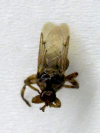Hippobosca longipennis--a potential intermediate host of a species of Acanthocheilonema in dogs in northern India
- PMID: 21781294
- PMCID: PMC3161949
- DOI: 10.1186/1756-3305-4-143
Hippobosca longipennis--a potential intermediate host of a species of Acanthocheilonema in dogs in northern India
Abstract
Background: Hippobosca longipennis (the 'dog louse fly') is a blood sucking ectoparasite found on wild carnivores such as cheetahs and lions and domesticated and feral dogs in Africa, the Middle East and Asia, including China. Known as an intermediate host for Acanthocheilonema dracunculoides and a transport host for Cheyletiella yasguri, it has also been suggested that H. longipennis may be a vector for other pathogens, including Acanthocheilonema sp.? nov., which was recently reported to infect up to 48% of dogs in northern India where this species of fly is known to commonly infest dogs. To test this hypothesis, hippoboscid flies feeding on dogs in Ladakh in northern India were collected and subjected to microscopic dissection.
Results: A total of 12 infective larvae were found in 10 out of 65 flies dissected; 9 from the head, 2 from the thorax and 1 from the abdomen. The larvae averaged 2, 900 (± 60) μm in length and 34 (± 5) μm in width and possessed morphological features characteristic of the family Onchocercidae. Genetic analysis and comparison of the 18S, ITS-2, 12S and cox-1 genes confirmed the identity of the larvae as the Acanthocheilonema sp.? nov. reported in dogs in Ladakh.
Conclusion: This study provides evidence for a potential intermediate host-parasite relationship between H. longipennis and the canine Acanthocheilonema sp.? nov. in northern India.
Figures







Similar articles
-
First molecular confirmation of the presence of Hippobosca longipennis (Diptera: Hippoboscidae) and infestation of sheltered dogs in Morocco.Parasit Vectors. 2025 May 27;18(1):193. doi: 10.1186/s13071-025-06830-y. Parasit Vectors. 2025. PMID: 40426188 Free PMC article.
-
First report of the dog louse fly Hippobosca longipennis in Romania.Med Vet Entomol. 2019 Dec;33(4):530-535. doi: 10.1111/mve.12395. Epub 2019 Jul 7. Med Vet Entomol. 2019. PMID: 31280502
-
Dipetalonema dracunculoides (Nematoda: Onchocercidae): first report in dog in Italy.Parasite. 2003 Jun;10(2):188. Parasite. 2003. PMID: 12847930 No abstract available.
-
Diagnostic exercise: abdominal parasites in a spider monkey.Lab Anim Sci. 1996 Jun;46(3):338-40. Lab Anim Sci. 1996. PMID: 8799943 Review. No abstract available.
-
Hippobosca equina L. (Hippoboscidae: Hippobosca)-An Old Enemy as an Emerging Threat in the Palearctic Zone.Int J Environ Res Public Health. 2022 Dec 17;19(24):16978. doi: 10.3390/ijerph192416978. Int J Environ Res Public Health. 2022. PMID: 36554859 Free PMC article. Review.
Cited by
-
Efficacy of a spot-on formulation containing moxidectin 2.5%/imidacloprid 10% for the treatment of Cercopithifilaria spp. and Onchocerca lupi microfilariae in naturally infected dogs from Portugal.Parasit Vectors. 2021 Apr 13;14(1):199. doi: 10.1186/s13071-021-04704-7. Parasit Vectors. 2021. PMID: 33849643 Free PMC article.
-
Focal Palatitis (Previously Focal Palatine Erosions) in Captive Cheetahs (Acinonyx jubatus).Front Vet Sci. 2021 Jul 12;8:682150. doi: 10.3389/fvets.2021.682150. eCollection 2021. Front Vet Sci. 2021. PMID: 34322534 Free PMC article.
-
Louse flies in Azorean and mainland populations of four Passeriformes species: A new perspective to parasite Island syndromes.Int J Parasitol Parasites Wildl. 2020 Dec 22;14:33-40. doi: 10.1016/j.ijppaw.2020.12.004. eCollection 2021 Apr. Int J Parasitol Parasites Wildl. 2020. PMID: 33384921 Free PMC article.
-
First molecular confirmation of the presence of Hippobosca longipennis (Diptera: Hippoboscidae) and infestation of sheltered dogs in Morocco.Parasit Vectors. 2025 May 27;18(1):193. doi: 10.1186/s13071-025-06830-y. Parasit Vectors. 2025. PMID: 40426188 Free PMC article.
-
Ultrastructural investigation of antennae in three cutaneous myiasis flies: Melophagus ovinus, Hippobosca equina, and Hippobosca longipennis (Diptera: Hippoboscidae).Parasitol Res. 2015 May;114(5):1887-96. doi: 10.1007/s00436-015-4376-4. Epub 2015 Feb 25. Parasitol Res. 2015. PMID: 25707367
References
-
- Maa TC. Notes on the Hippoboscidae (Diptera), I. Pac Insects. 1962;4:583–614.
-
- Bequaert J. Notes on Hippoboscidae 2. The subfamily Hippoboscinae. Psyche (Stuttg) 1930;XXXVII:303–326.
-
- Bequaert J. Notes on Hippoboscidae 13. A second revision of the Hippoboscinae. Psyche (Stuttg) 1940;XLVII:70–90.
-
- Bhat HR, Kulkarni SM. A survey of haematophagus arthropods in western Himalayas, Sikkim and hill districts of West Bengal: Pupipara (Diptera) (families: Hippoboscidae, Nycteribiidae and Streblidae) Ind J Med Res. 1974;62:1121–1133. - PubMed
Publication types
MeSH terms
LinkOut - more resources
Full Text Sources

